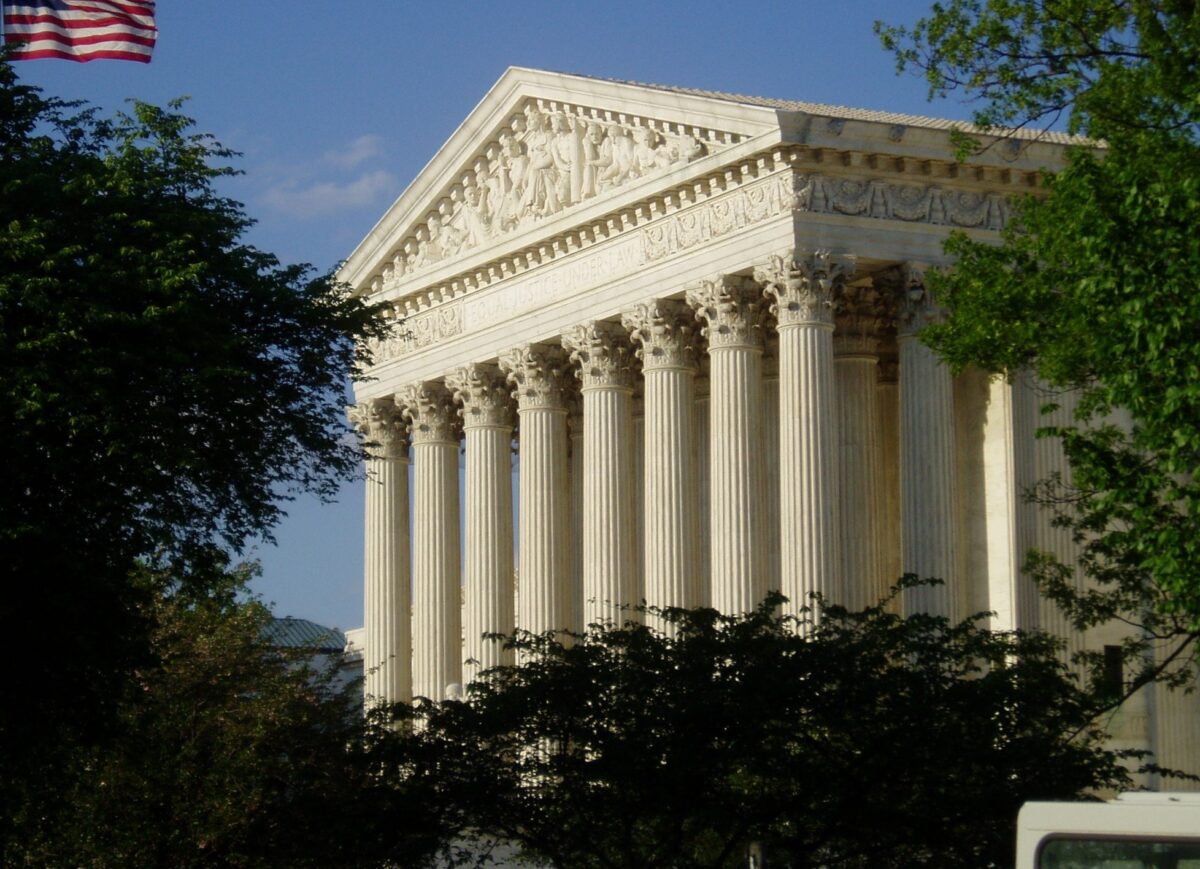Court will consider whether painting made from photo is lawful
By Carolyn Schurr Levin and Gillian Vernick
Fair use is a term that is thrown around often — and often improperly. Students may say, “I can use that photo because I know the person who posted it,” or “this song was on TikTok so it’s fine to quote the lyrics.” In both of these examples, the students rely (incorrectly) on the woefully misunderstood concept of fair use.
On Oct. 12, 2022, the U.S. Supreme Court will have a chance to clarify the fair use doctrine when it hears the case of Andy Warhol Foundation for the Visual Arts, Inc. v. Goldsmith. This will be the first time the Supreme Court considers a fair use defense applied to a photograph (although last year the Court decided Google v. Oracle, a fair use dispute concerning computer code).

In the current case, Warhol v. Goldsmith, celebrity portrait photographer Lynn Goldsmith (her Wikipedia bio describes her as “one of the first female rock and roll photographers”), photographed the recording artist Prince back in December 1981, while she was on assignment for Newsweek. At the time Goldsmith took the photos, Prince was a relatively unknown musician, and the photographs were not published. Three years later, when Prince’s Purple Rain album made him a star, Vanity Fair magazine licensed one of Goldsmith’s photographs for $400, and commissioned the artist Andy Warhol to create artwork for a feature in the magazine. Goldsmith’s photograph was to serve as “an artist reference for an illustration to be published in Vanity Fair.”

In Warhol’s iconic style, he cropped the image, resized and altered it, changing the tones, lighting and detail of the photo and adding layers of coloring and shading. Warhol’s artwork ran in Vanity Fair, credited to Warhol, and to Goldsmith for the source photograph. Goldsmith was not aware of that use of her Prince photograph as the reference source until after Prince died in 2016. The dispute then emerged when the Andy Warhol Foundation for the Visual Arts (the owner of Warhol’s copyrights after he died) licensed Warhol’s “Prince Series” for use in a magazine commemorating Prince’s life. Conde Nast, the owner of Vanity Fair, paid $10,000 for one of Warhol’s pictures. The artwork appeared on the cover of a special “The Genius of Prince” magazine in May 2016, with no image copyright credit to Goldsmith. Goldsmith claimed that this use, for which she did not receive any fee, denied her licensing opportunities for her photographs. She brought a copyright infringement case, and that case has now been winding its way through the federal courts since 2017.
The question that the Supreme Court will consider is whether the Warhol Foundation’s licensing to Conde Nast of Warhol’s Prince artwork was an infringement of Goldsmith’s original photograph, or whether Warhol’s artwork constitutes fair use.
Fair use is a defense to a copyright infringement claim that is built right into the federal copyright law. A fair use analysis considers four factors:
-
- the purpose and character of the use—whether it is a commercial or non-profit/educational purpose;
- the nature of the copyrighted work—creative, published or unpublished;
- the amount and substantiality of the portion used in relation to the copyrighted work as a whole; and
- the market effect of the infringing use—whether it usurps the copyright owner’s market for his or her original work.
For instance, copying and distributing a magazine article as part of a fundraising effort has been found to be fair use, as it did not affect magazine sales. Conversely, publishing unpublished excerpts of a forthcoming memoir of a public figure was found not to be fair use, as the copying seriously damaged the marketability of the impending publication.
If there is a dispute about whether the use of copyrighted material is infringing or constitutes fair use, a court will balance the four fair use factors.
Recent lower court cases have often focused on the purpose and character of the use, and whether the allegedly infringing work is “transformative.” They analyze whether the use of the material transforms the original work into something new. For instance, the Supreme Court found that a rap group borrowing the opening bass riff and first line of a song but adding its own lyrics weighed in favor of a fair use finding, as the rap song conveyed a parodic purpose and character from the original, transforming the meaning or message.
At the trial in 2019, federal judge John G. Koeltl in Manhattan found Warhol’s Prince Series to be a fair use of the Goldsmith photo, as Warhol “transformed Prince from a vulnerable, uncomfortable person to an iconic larger-than-life figure” in his works. In March 2021, though, a three-judge federal appeals court reversed that fair use finding, ruling instead in favor of photographer Goldsmith. The appeals court found that the Warhol series was “substantially similar to the Goldsmith photograph as a matter of law.” The Warhol Foundation appealed to the U.S. Supreme Court, where the case is now waiting to be heard.
Many media organizations are interested in the outcome of this case. Amicus briefs (where non-parties can weigh in to advocate for interests that the parties to the case might not directly articulate) have been filed on behalf of both sides in the Supreme Court. Seventeen friend-of-the-court briefs have been filed in favor of the Warhol Foundation, including briefs from a group of Copyright Law Professors, Art Law Professors, the Electronic Frontier Foundation, and The Motion Picture Association, all lobbying the Court to find in favor of Warhol’s transformative use of the photograph without permission. On the other side, 19 groups filed in support of photographer Lynn Goldsmith, including the American Photographic Artists and the National Press Photographers Association, arguing that Warhol’s works based on Goldsmith’s photograph constitute unauthorized derivative portraits that captured the same nature and characteristics of Goldsmith’s photo and damage the market for photographers creating original work.
As student journalists use more and more third-party content found on the internet in their reporting, including photographs, blog posts, tweets, Instagram posts, song lyrics, and more, knowing the ins and outs of fair use is a critical skill. A Supreme Court decision against the Warhol Foundation would signal a walk-back of transformative use/fair use concepts under federal copyright law; many have understood copyright law as promoting arts and science by permitting such inspired uses of original works.
If the Supreme Court upholds the federal appeals court ruling that Warhol’s use was infringing, student journalists will need to do even more in-depth analysis on the creation and use of graphics, art, and photos based on underlying source materials. In general, if journalists use a substantial portion of copyrighted work, like a photo, for generally the same purpose, without making significant creative changes to the underlying work, this use is likely infringing. Simply conveying a different purpose or intent behind use of the work will not hold as much weight in insulating journalists from copyright infringement claims if the original work is not significantly transformative.
And because there are no registration requirements under federal copyright law (there is no need to register the copyright in your work in order to own a valid copyright), student journalists and their advisers should assume that every independent work is someone else’s copyright protected material, and the use either must be fair or licensed with permission by the owner.
Fair use is complicated. Taking the time to fully analyze all uses of third-party materials is essential, both to good journalism and to the avoidance of infringement claims.

Carolyn Schurr Levin, a media and First Amendment attorney, is a partner at Miller Korzenik Sommers Rayman LLP in New York. She was the vice president and general counsel of Newsday, vice president and general counsel of Ziff Davis Media, and media law adviser for the School of Journalism at Stony Brook University. She teaches Media Ethics & Law at City University of New York’s Baruch College, and has also taught media ethics and law at Stony Brook University, Long Island University, and Pace University. From 2010-2019, she was the faculty adviser for the Pioneer, the student newspaper at Long Island University, during which time the Pioneer won 28 awards.
 Gillian Vernick is an associate at Miller Korzenik Sommes Rayman LLP in New York. She was previously the Technology and Press Freedom Project Fellow at the Reporters Committee for Freedom of the Press. She graduated from the Drexel University Thomas R. Kline School of Law and the Philip Merrill College of Journalism at the University of Maryland.
Gillian Vernick is an associate at Miller Korzenik Sommes Rayman LLP in New York. She was previously the Technology and Press Freedom Project Fellow at the Reporters Committee for Freedom of the Press. She graduated from the Drexel University Thomas R. Kline School of Law and the Philip Merrill College of Journalism at the University of Maryland.

